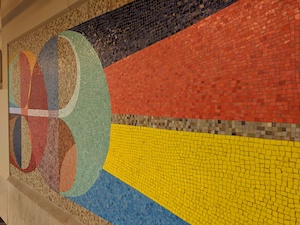

The founders of the New York City subway believed that every design element in the system should show respect to its customers and enhance the experience. Continuing that tradition during a massive rebuilding of the system, MTA launched an Arts & Design division in the 1980s. This division oversees the selection of artists and installations that are permanently installed throughout the MTA system, “creating a first-rate museum filled with more than 300 works by world famous, mid-career and emerging artists,” and connecting commuters with people, sites and surrounding neighborhoods.
As part of major renovations to nine stations along the Sea Beach Line (N) in Brooklyn, artists were selected to create permanent artwork for inclusion in the station renovations. The nine stations under construction were originally opened in 1915, and the now-completed capital construction included improvements to each station’s platforms, overpasses, stairways, canopies and columns, in addition to permanent artwork.
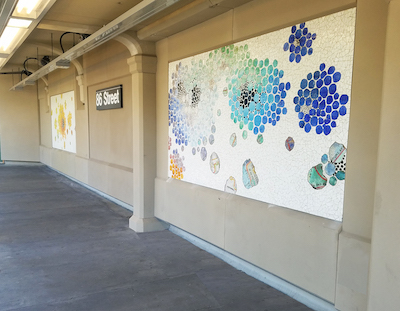

Four of the artists selected for the Sea Beach Line projects – Sally Gil, Karen Margolis, Eamon Ore-Giron and Emilio Perez – selected Mosaicos Venecianos De México, a member of TCNA Mexico, to translate their designs into smalti (enamel glass mosaics). The pieces were fabricated with LATICRETE® products and shipped to New York for their installation along the platforms at MTA New York City Transit Authority’s 86th Street, Avenue U, 18th Avenue and Bay Parkway stations.
“Given the architectural requirements of these stations, we pre-mounted and grouted the designs on aluminum panels using products from LATICRETE, a prestigious brand leader in installation systems that we knew were tested and guaranteed for high-performance and ideal for exterior applications,” said Malena Perdomo of Mosaicos Venecianos De México.
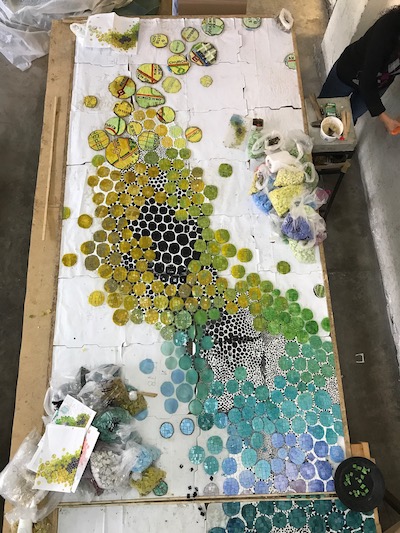

High-traffic and extreme temperature challenges
High-traffic installation: Just like New York City, the MTA stations never sleep. Even though the company pre-mounted and grouted the artwork on aluminum panels ready for mounting to each station’s platform walls, the installations needed to be done quickly to minimize interruption to MTA customers.
Extreme temperatures: New York City can range in temperatures from -15 degrees Fahrenheit (-26 Celsius) to upwards of 106 degrees Fahrenheit (41 degrees Celsius), so it was important that the installation products chosen would be able to thrive in extreme climates to resist fractures and possible humidity issues.
A LATICRETE solution
Artists Karen Margolis and Sally Gil focused their artwork on pieces that reflect the local landscape. At the Avenue U station, artist Sally Gil’s work was recreated in a series of 14 mosaic panels titled “Edges of a South Brooklyn Sky.” Each of the pieces she created reflects the surrounding Gravesend neighborhood. For the 86th Street station, artist Karen Margolis created “Cerebration,” a glass mosaic artwork that similarly connects people and place by transcribing destinations of the surrounding area into the mosaic work.
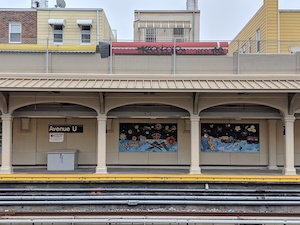

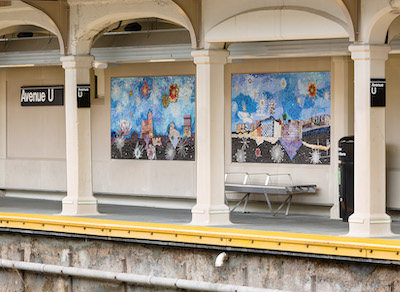

Artist Eamon Ore-Giron created an expansive mosaic project entitled “People’s Instinctive Travels: Homage to The Tribe” that was based on six, original oil-on-linen paintings that were translated into 24 glass mosaic panels at the Bay Parkway station.
At the 18th Avenue station, artist Emilio Perez’s work was made into 22 abstract mosaic murals called “Fluxus/Rhythmus.” In an email conversation with Cuban Art News, Perez credited this installation as the first of his works to be translated into mosaic panels.
“It was important for the mosaic to reflect the variations of color in a brushstroke to create the sense of movement,” said Perez. “What I discovered is that the process used for making the different color glass creates variations of tone much like a brushstroke. This made for a seamless transition of materials.”
Each of the art installations was adhered to aluminum panels with LATAPOXY® 300 Adhesive, a chemical-resistant epoxy adhesive that is easily spread and tenaciously bonds to challenging substrate types. With this adhesive, the mosaic panels stayed perfectly in place while on their excursion to New York, as well as during the fast installations that took place once onsite at the stations.
SPECTRALOCK® PRO Grout, a patented, high-performance epoxy grout, was used to finish off the pieces. SPECTRALOCK PRO Grout is designed for use on glass tile applications and is great for exterior installations like those at the stations. This product also offers superb color uniformity, durability and stain resistance that will stand the test of time. Additionally, the grout is crack resistant and ideal for installation in areas with a wide range in temperatures – perfect for outdoors.
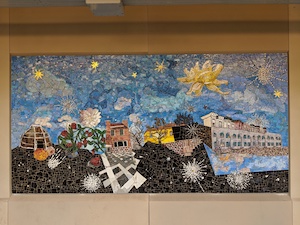

Each of the products used received UL GREENGUARD Gold Certifications for low chemical emissions for sustainable building and Health Product Declaration (HPD). This open standard provides complete, transparent disclosure of the potential chemicals of concern by analyzing and comparing all product raw materials to authoritative chemical hazard lists from around the world.
Outcome
“Mosaicos Venecianos De México is a talented fabricator that brought the artists’ work alive,” said LATICRETE Strategic Innovation Manager Samantha Rothberg. “More than eight million people will get the privilege to enjoy the mosaic panel designs daily and LATICRETE products helped make that possible.”
The work of Sally Gil, Karen Margolis, Eamon Ore-Giron and Emilio Perez, commissioned by MTA Arts & Design and recreated by Mosaicos Venecianos De México is displayed prominently and permanently at their respective stations.
